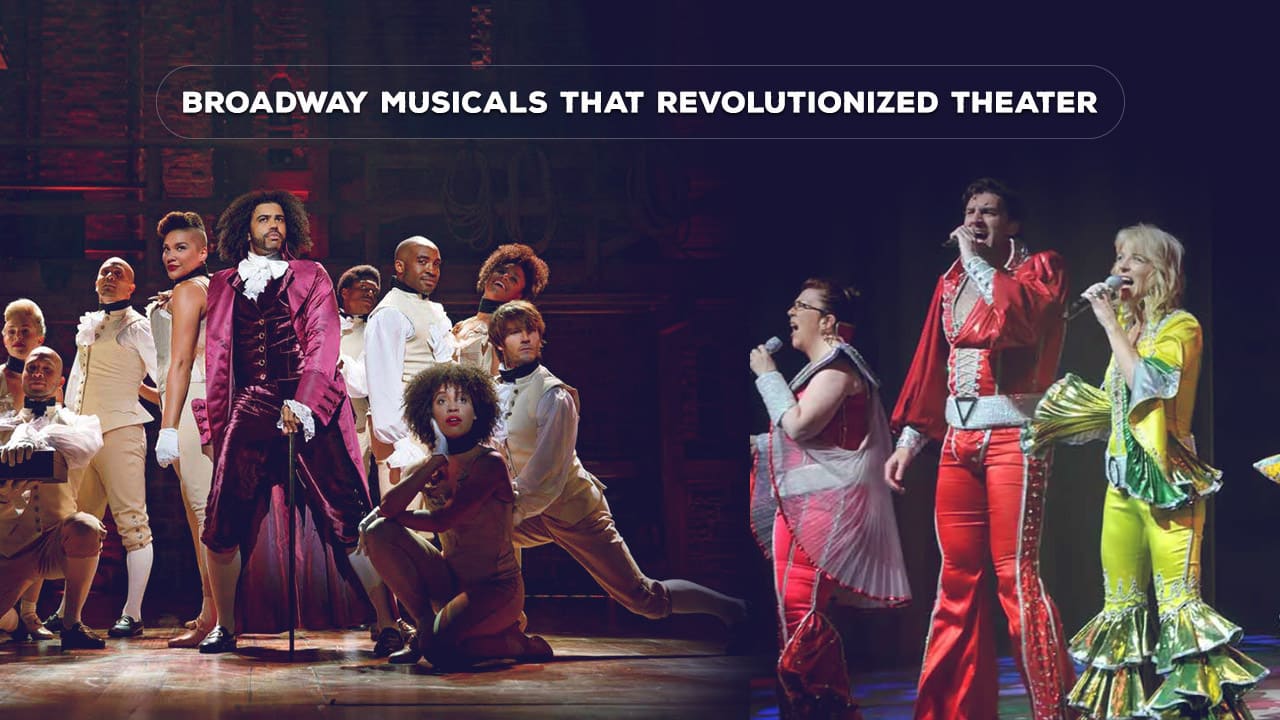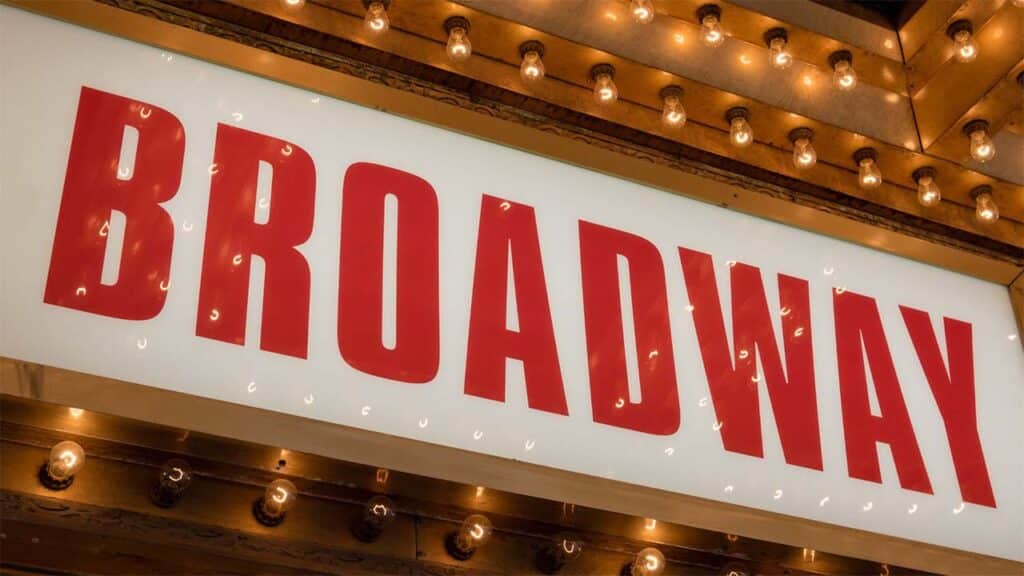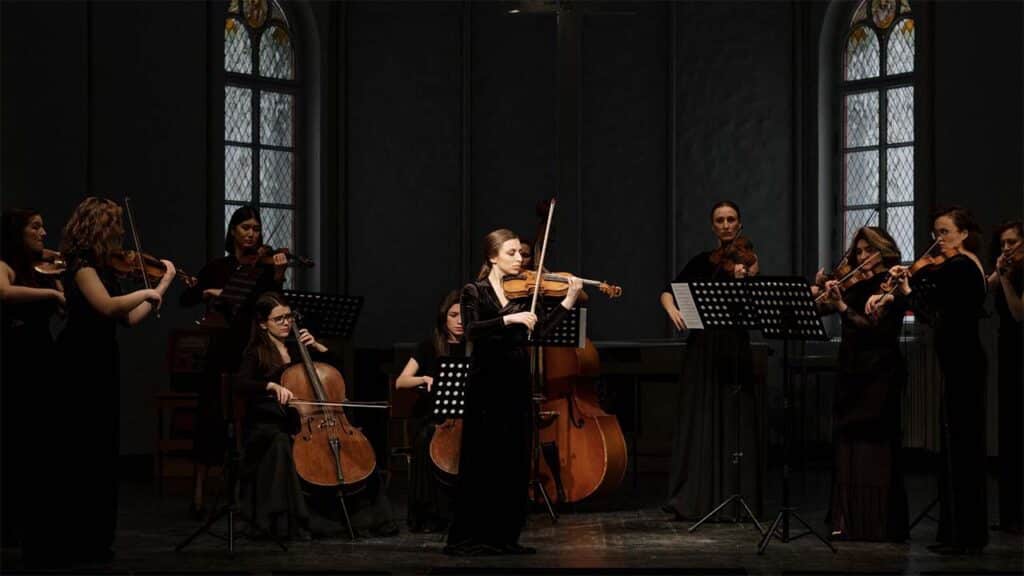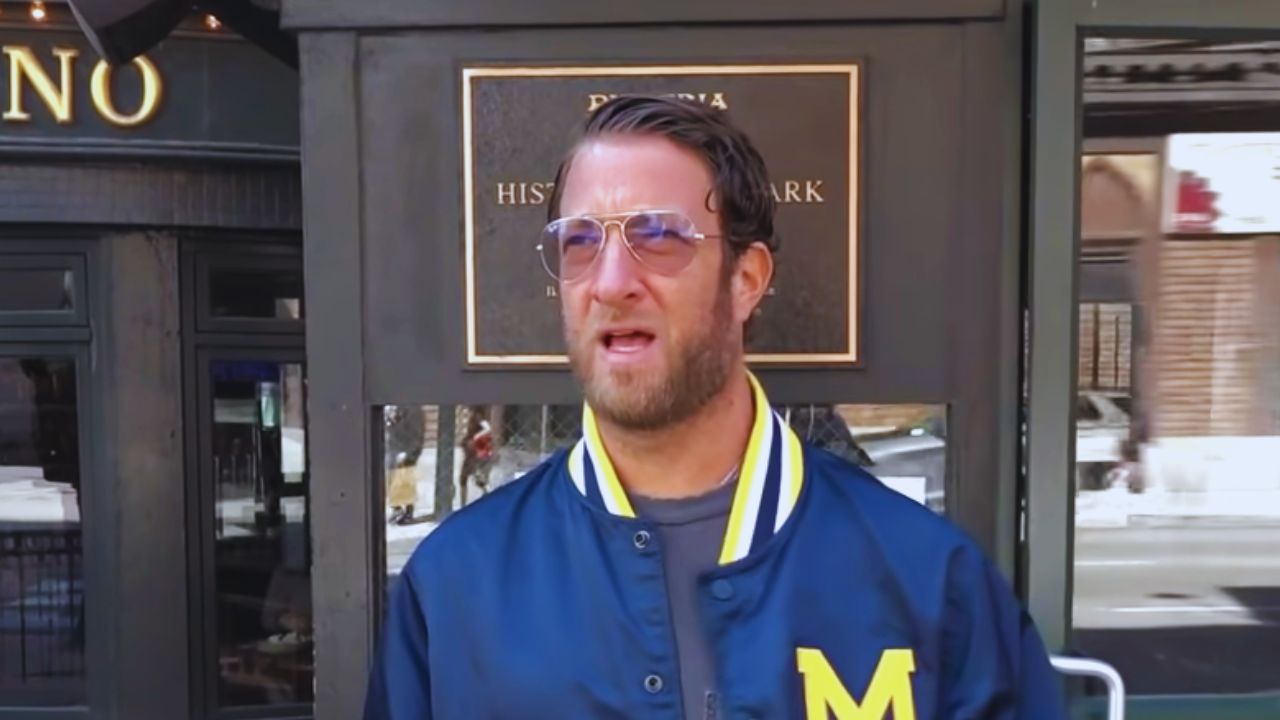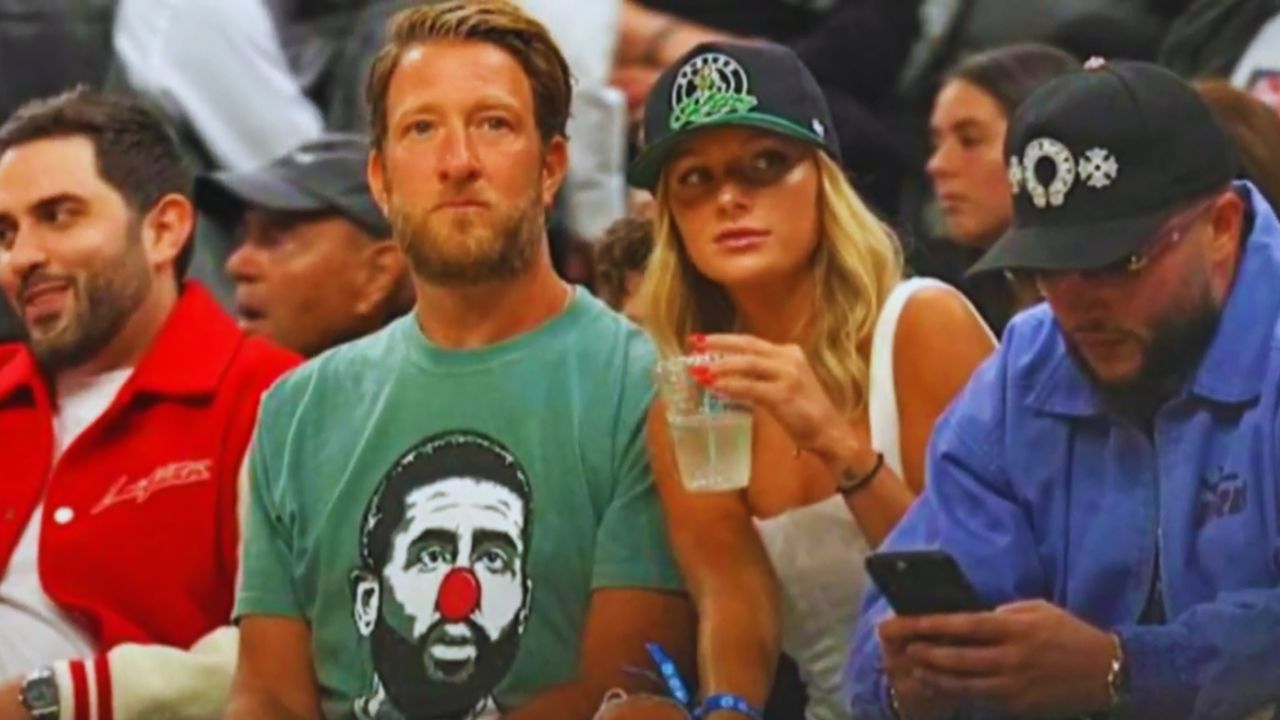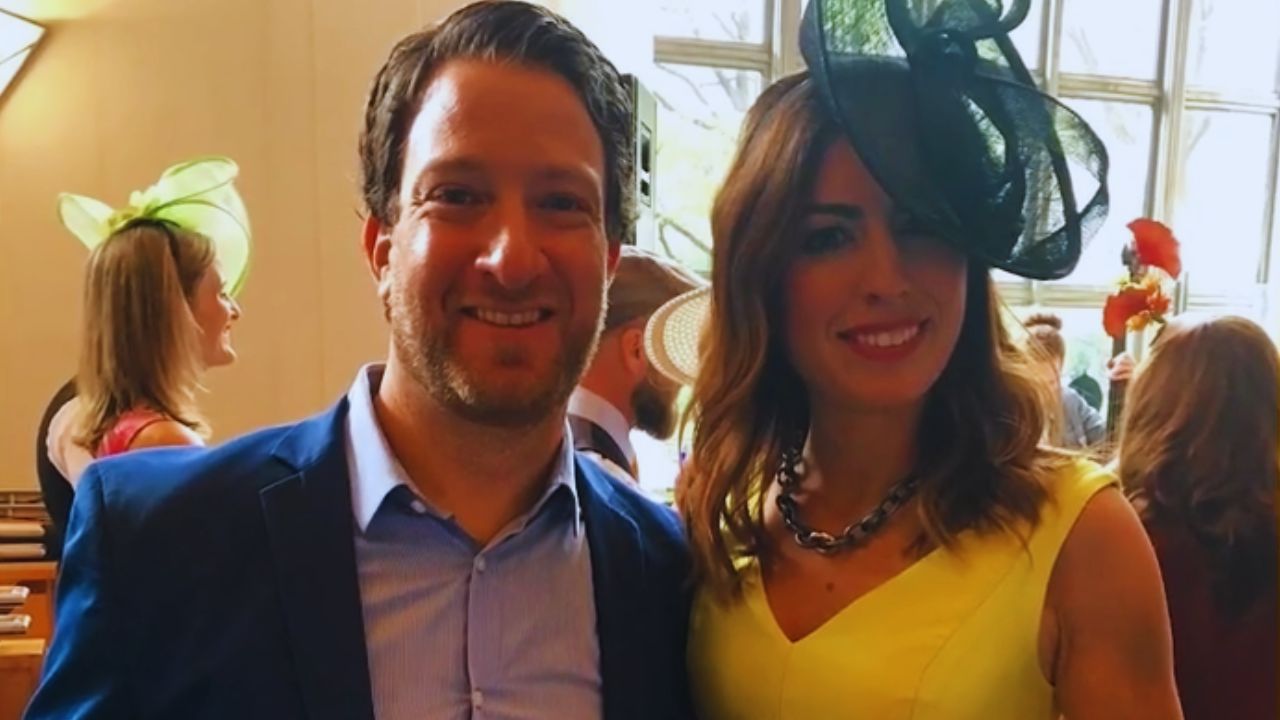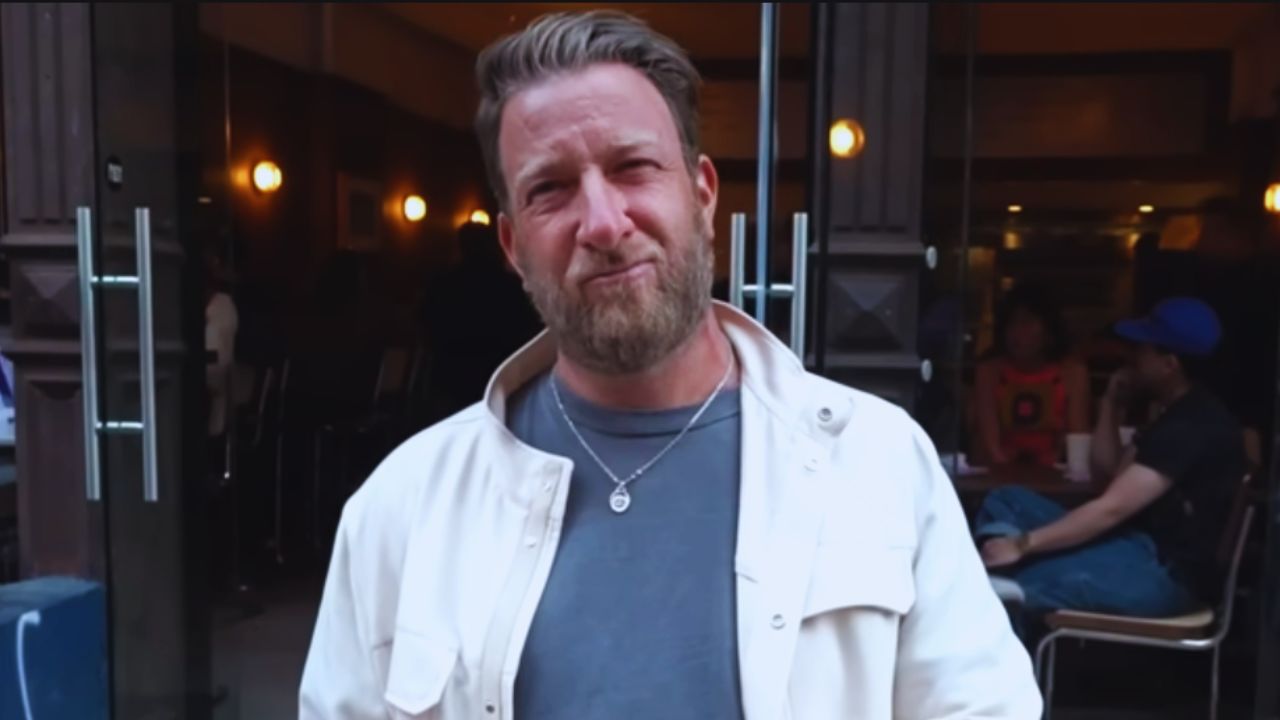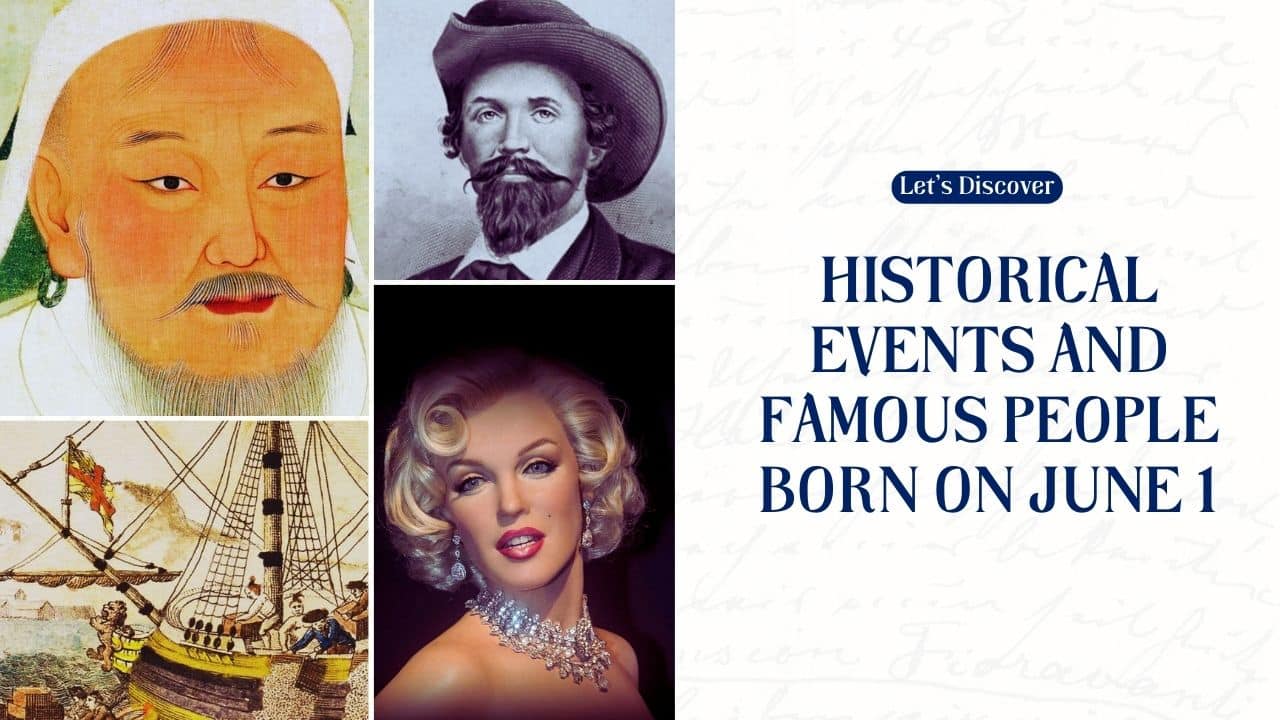Broadway musicals have captivated audiences for over a century. These magical productions blend music, dance, and storytelling to create unforgettable experiences. From catchy tunes to dazzling sets, Broadway shows transport you to new worlds and stir deep emotions.
Some musicals have gone beyond entertainment, changing theater forever. These groundbreaking shows pushed boundaries, tried new ideas, and set new standards.
They paved the way for future innovations and inspired generations of artists. By looking at these influential musicals, you can see how Broadway has grown and evolved over time.
1. Hamilton
Hamilton burst onto Broadway in 2015. It changed how people think about musicals. The show tells the story of Alexander Hamilton, a founding father of America.
Lin-Manuel Miranda wrote the songs and starred in the lead role. He mixed hip-hop, jazz, and R&B with traditional show tunes. This fresh sound attracted new audiences to theater.
The cast was very diverse. People of color played white historical figures. This choice made the show feel modern and relevant.
Hamilton’s lyrics are clever and packed with information. You learn a lot about early American history while enjoying the music.
The show became a huge hit. Tickets were hard to get. People listened to the soundtrack over and over.
Hamilton won 11 Tony Awards. It also got a Pulitzer Prize for Drama. The show toured all over the world.
You can watch a filmed version of Hamilton on Disney+. This let even more people experience the groundbreaking musical.
Hamilton proved that musicals can tackle serious topics in new ways. It inspired other creators to take risks with their shows.
2. Rent
Rent shook up Broadway when it debuted in 1996. This rock musical told the story of struggling artists in New York City during the AIDS crisis.
Jonathan Larson wrote Rent based on his own experiences. Sadly, he died suddenly, just before the show’s first preview performance.
The musical tackled tough subjects like HIV/AIDS, drug addiction, and poverty. It featured diverse characters and same-sex relationships rarely seen on Broadway before.
Rent’s music blended rock, pop, and musical theater styles. Songs like “Seasons of Love” became instant classics.
The show won multiple Tony Awards and a Pulitzer Prize for Drama. It ran on Broadway for 12 years and inspired productions worldwide.
Rent made theater more accessible to young people. The producers offered $20 tickets for the first two rows at every show.
This policy created “Rent-heads” – super fans who saw the show repeatedly. It helped build a devoted following for the musical.
Rent paved the way for more diverse and socially conscious shows on Broadway. Its influence can still be seen in musicals today.
3. The Phantom of the Opera
“The Phantom of the Opera” changed Broadway forever when it opened in 1988. This musical by Andrew Lloyd Webber has dazzled audiences for over 35 years.
The grand spectacle and eerie melodies will enthrall you. The show tells a tragic love story set in a Paris opera house.
The Phantom’s iconic mask and chandelier crash are unforgettable moments. These theatrical tricks wowed crowds and set new standards for special effects on stage.
Lloyd Webber’s lush score blends opera and rock influences. Songs like “Music of the Night” and “All I Ask of You” became instant classics.
“Phantom” broke records as the longest-running Broadway show ever. It surpassed “Cats” in 2006 and kept going strong.
The musical’s success spawned productions worldwide. You can see it in London’s West End, where it premiered in 1986.
“Phantom” won seven Tony Awards, including Best Musical. It proved that big-budget spectacles could also have artistic merit.
The show’s mix of romance, mystery, and visual splendor created a new template for blockbuster musicals. You can see its influence in later hits like “Wicked” and “The Lion King.”
4. Les Misérables
Les Misérables took Broadway by storm when it premiered in 1987. This musical adaptation of Victor Hugo’s novel captivated audiences with its powerful story and memorable songs.
Set in 19th century France, Les Misérables follows the journey of Jean Valjean, an ex-convict seeking redemption. The show tackles themes of justice, love, and revolution through its sweeping narrative.
Claude-Michel Schönberg’s music and Alain Boublil’s lyrics bring the characters to life. You’ll find yourself humming tunes like “I Dreamed a Dream” and “One Day More” long after the curtain falls.
Les Misérables changed Broadway with its sing-through format. Almost every line is sung rather than spoken, creating a unique theatrical experience.
The show’s epic scope and emotional depth resonated with audiences worldwide. It has been performed in over 40 countries and translated into more than 20 languages.
Les Misérables has won numerous awards, including eight Tony Awards in its original Broadway run. Its impact on musical theater is undeniable, inspiring a new generation of ambitious, story-driven shows.
The musical’s longevity is a testament to its revolutionary nature. It continues to draw crowds decades after its debut, with revivals and tours keeping the spirit of Les Misérables alive on stages across the globe.
5. West Side Story
West Side Story burst onto Broadway in 1957, changing musical theater forever. This groundbreaking show reimagined Shakespeare’s Romeo and Juliet in 1950s New York City.
You’ll find the familiar tale of star-crossed lovers, but with a twist. Instead of warring families, it’s rival street gangs – the Jets and the Sharks.
The creative team behind West Side Story was legendary. Leonard Bernstein composed the music, while Stephen Sondheim wrote the lyrics. Jerome Robbins directed and choreographed the show.
West Side Story broke new ground with its gritty portrayal of urban life and social issues. It tackled themes of racism, violence, and immigration head-on.
The show’s dance numbers were revolutionary. Robbins blended ballet with street dancing to create a unique, energetic style.
Bernstein’s score became iconic. Songs like “Maria,” “Tonight,” and “Somewhere” are now classics of musical theater.
West Side Story has been revived on Broadway multiple times. A 2020 production directed by Ivo van Hove brought fresh perspectives to the timeless story.
The show’s impact extends beyond the stage. It was adapted into an Oscar-winning film in 1961 and again in 2021.
West Side Story’s influence on musical theater is immeasurable. It paved the way for more complex, socially conscious musicals in the decades that followed.
6. A Chorus Line
“A Chorus Line” burst onto Broadway in 1975 and changed musical theater forever. This groundbreaking show pulled back the curtain on the audition process. You got to see dancers competing for spots in a chorus line.
The musical stripped away fancy sets and costumes. Instead, it put the focus on the performers themselves. You watched as they shared their hopes, fears, and personal stories.
“A Chorus Line” was a new kind of concept musical. It didn’t follow a traditional plot. The audition itself was the story. This fresh approach grabbed audiences and critics alike.
The show’s catchy songs became instant classics. “One” and “What I Did for Love” are still beloved today. But it wasn’t just about the music. The raw emotion of the dancers’ stories touched people deeply.
“A Chorus Line” ran for an amazing 15 years on Broadway. It won nine Tony Awards and a Pulitzer Prize. The show proved that musicals could tackle real-life issues and still be entertaining.
Its influence can still be seen in modern musicals. Many shows now feature simple sets and focus on character stories. “A Chorus Line” truly revolutionized what a Broadway musical could be.
7. Chicago
“Chicago” burst onto Broadway in 1975, bringing a dark and dazzling tale of crime and celebrity to the stage. The show’s creators, John Kander, Fred Ebb, and Bob Fosse, crafted a satirical masterpiece that still resonates today.
The jazzy score and provocative dance numbers will enthrall you. The musical tells the story of Roxie Hart and Velma Kelly, two murderesses vying for fame in 1920s Chicago. Their quest for stardom exposes the corruption of the criminal justice system and the media.
Fosse’s iconic choreography became synonymous with the show. The sleek, sexy movements perfectly capture the show’s themes of seduction and manipulation. You’ll recognize the influence of his style in countless productions since.
“Chicago” was ahead of its time in its cynical view of American culture. It predicted our obsession with celebrity criminals and media sensationalism. This relevance has helped it become the longest-running American musical in Broadway history.
The 1996 revival breathed new life into the show. It stripped down the set and costumes, putting the focus on the performers and the timeless story. This minimalist approach proved incredibly successful, running for over 25 years and counting.
8. Cats
Cats changed Broadway forever when it opened in 1982. This sung-through musical by Andrew Lloyd Webber brought a new level of spectacle to the stage.
Based on T.S. Eliot’s poetry, Cats tells the story of a tribe of felines. The show’s unique concept and elaborate costumes wowed audiences.
At $4.5 million, Cats was the most expensive musical in Broadway history at the time. Its top ticket price of $45 was also unprecedented.
The show’s marketing was revolutionary. It used a simple black-and-yellow logo that became instantly recognizable worldwide.
Cats ran for 18 years on Broadway, setting a longevity record. It paved the way for other British “mega-musicals” to find success in New York.
The musical’s elaborate junkyard set and acrobatic choreography pushed technical boundaries. It showed how stagecraft could create immersive theatrical worlds.
Cats helped usher in an era of family-friendly spectacles on Broadway. Its broad appeal attracted tourists and made theatergoing a must-do activity for visitors to New York.
9. The Lion King
The Lion King roared onto Broadway in 1997, changing musical theater forever. This adaptation of the beloved Disney film brought the African savanna to life on stage.
Director Julie Taymor’s innovative vision transformed actors into animals using intricate masks and puppetry. Her groundbreaking designs merged African art with modern stagecraft.
The show’s music, featuring Elton John and Tim Rice’s songs from the film plus new compositions, became instantly iconic. “Circle of Life” and “Can You Feel the Love Tonight” are now Broadway classics.
You’ll be amazed by the spectacle of Pride Rock rising from the stage and herds of gazelles leaping across the theater. The Lion King’s visual storytelling is unlike anything you’ve seen before.
This musical has captivated audiences for over 25 years. It’s one of the longest-running and highest-grossing shows in Broadway history.
The Lion King’s success spawned productions worldwide. You can now see Simba’s story in over 100 cities across 20 countries.
Its universal themes of family, responsibility, and finding your place resonate with people of all ages. The show’s emotional power and stunning artistry continue to inspire new generations of theatergoers.
10. Wicked
Wicked burst onto Broadway in 2003, changing the landscape of musical theater forever. Based on Gregory Maguire’s novel, it tells the untold story of the witches of Oz.
You might know the Wicked Witch of the West as the villain from The Wizard of Oz. But Wicked flips that tale on its head. It shows you Elphaba’s journey from misunderstood outcast to powerful witch.
The show’s catchy songs by Stephen Schwartz quickly became fan favorites. “Defying Gravity” and “Popular” are now Broadway classics. You can hear people humming these tunes long after leaving the theater.
Wicked broke box office records and won multiple Tony Awards. It’s been running for over 20 years, enchanting audiences night after night. The show’s themes of friendship, acceptance, and standing up for what’s right resonate with people of all ages.
The musical’s success led to productions around the world. It’s been translated into many languages, spreading its magic globally. Wicked has inspired a generation of theatergoers and aspiring performers.
You can see Wicked’s influence in many new musicals. Its mix of spectacle, heart, and social commentary set a new standard for Broadway shows. It proved that a musical could be both entertaining and thought-provoking.
11. The Book of Mormon
The Book of Mormon hit Broadway in 2011 and changed musical theater forever. This show blends comedy and religion in a way you’ve never seen before.
It tells the tale of two Mormon missionaries who work in Uganda. Trey Parker, Matt Stone, and Robert Lopez created it. The musical pokes fun at religion, but does so with a surprisingly big heart.
When it opened, The Book of Mormon was an instant hit. Critics loved it, and tickets were hard to get. It won nine Tony Awards, including Best Musical.
The show’s songs are catchy and often shocking. They push boundaries while making you laugh and think. Numbers like “Hello!” and “I Believe” became fan favorites.
What makes The Book of Mormon special is how it balances satire with genuine emotion. It’s not just about making jokes. The characters grow and learn throughout the story.
This musical proved that Broadway could tackle tough topics with humor and heart. It opened doors for more daring shows to follow. Years later, people still line up to see it.
12. Dear Evan Hansen
Dear Evan Hansen burst onto Broadway in 2016. It quickly became a sensation. The show tells the story of a high school student with social anxiety.
You might wonder what makes it special. The musical tackles tough topics like loneliness and mental health. It does this in a way that connects with audiences of all ages.
The songs, written by Benj Pasek and Justin Paul, are catchy and emotional. You’ll find yourself humming tunes like “Waving Through a Window” long after the show ends.
Dear Evan Hansen won six Tony Awards in 2017. This included Best Musical and Best Actor for Ben Platt’s performance as Evan.
The show changed how musicals talk about mental health on stage. It opened up conversations about anxiety and depression among teens and adults.
You’ll see how social media plays a big role in the story. This makes it very relevant to today’s world.
The musical’s success led to a film adaptation in 2021. It also inspired many high schools to put on their own productions.
Dear Evan Hansen proved that Broadway can tackle serious issues while still being entertaining. It paved the way for more shows to explore complex themes.
13. Hairspray
Hairspray burst onto Broadway in 2002, bringing a fresh dose of energy to the musical theater scene. Based on John Waters’ 1988 film, this show tackled important social issues with catchy tunes and vibrant dance numbers.
Set in 1962 Baltimore, Hairspray follows Tracy Turnblad, a plus-sized teen with big dreams. She wants to dance on TV and fight racial segregation. The musical’s upbeat score by Marc Shaiman and Scott Wittman perfectly captures the sound of the early 1960s.
You’ll find yourself tapping your toes to songs like “Good Morning, Baltimore” and “You Can’t Stop the Beat.” These catchy tunes help deliver powerful messages about body positivity and racial equality.
Hairspray stands out for its clever blend of comedy and social commentary. It addresses serious topics while keeping the mood light and fun. This approach made it accessible to a wide audience.
The show’s success sparked a renewed interest in feel-good musicals with a message. It won eight Tony Awards, including Best Musical, and ran for over 2,500 performances on Broadway.
Hairspray’s impact extends beyond its initial run. It inspired a hit movie adaptation in 2007 and continues to be performed in schools and community theaters worldwide.
14. Next to Normal
Next to Normal shook up Broadway in 2008 with its raw portrayal of mental illness. This rock musical dives into the life of a mother battling bipolar disorder and how it affects her family.
The show tackles heavy topics like grief, depression, and drug abuse. It doesn’t shy away from the dark side of suburban life. The music packs a punch with over 30 original songs that will stick in your head.
You’ll find yourself drawn into the family’s struggles. The mother’s journey is both heartbreaking and inspiring. The show gives you a glimpse into the challenges of living with mental illness.
Next to Normal broke new ground by bringing these tough issues to the stage. It showed that musicals can tackle serious topics and still captivate audiences. The show won three Tony Awards and a Pulitzer Prize for Drama.
When you see Next to Normal, you’ll experience a range of emotions. It’s not your typical feel-good musical, but it leaves a lasting impact. The show proves that theater can be a powerful tool for sparking conversations about mental health.
15. Spring Awakening
Spring Awakening burst onto Broadway in 2006, shaking up musical theater with its bold approach to teenage sexuality and angst. This rock musical, based on an 1891 German play, brought a fresh sound to the stage.
Duncan Sheik’s alt-rock score and Steven Sater’s lyrics captured the turmoil of adolescence in late 19th-century Germany. The show tackled taboo topics like teen pregnancy, abuse, and suicide.
You might be surprised by how Spring Awakening blended contemporary music with a historical setting. This contrast highlighted the timeless nature of teenage struggles.
The musical won eight Tony Awards, including Best Musical. It launched the careers of stars like Lea Michele and Jonathan Groff.
Spring Awakening’s innovative staging used handheld microphones and simple sets. This stripped-down approach lets the powerful emotions of the story shine through.
The show’s frank portrayal of sexuality and its rock soundtrack appealed to younger audiences. It brought a new generation of theatergoers to Broadway.
Spring Awakening paved the way for more diverse and daring musicals. Its success showed producers that risky, unconventional shows could find an audience on Broadway.
16. In the Heights
“In the Heights” brought a fresh voice to Broadway in 2008. Lin-Manuel Miranda created this vibrant musical set in Washington Heights, New York City.
The show blends hip-hop, salsa, and Latin music with traditional musical theater. It tells the story of a tight-knit Latino community facing change and chasing dreams.
You’ll hear characters rap and sing about their hopes, struggles, and love for their neighborhood. The music pulses with energy and emotion, capturing the spirit of Washington Heights.
“In the Heights” won four Tony Awards, including Best Musical. It proved that Broadway was ready for new sounds and stories from diverse voices.
The show paved the way for Miranda’s later hit “Hamilton.” It showed that hip-hop could work on stage and that Latino stories could appeal to a wide audience.
“In the Heights” inspired a new generation of theater creators. It encouraged more diverse casting and storytelling on Broadway.
In 2021, the musical became a hit movie. This brought its joyful celebration of community to an even bigger audience.
17. Evita
“Evita” burst onto the theater scene in 1978, changing the face of musical theater. This rock opera tells the story of Eva Perón, Argentina’s beloved First Lady.
Andrew Lloyd Webber and Tim Rice created a masterpiece that blended politics, history, and music. The show’s unique style captivated audiences in London’s West End and on Broadway.
“Don’t Cry for Me Argentina” became an instant classic. This powerful ballad showcased the emotional depth of the musical. You might find yourself humming it long after leaving the theater.
Patti LuPone’s performance as Eva Perón on Broadway was unforgettable. Her portrayal set a new standard for leading ladies in musicals. The role of Eva continues to attract top talent today.
“Evita” broke new ground by tackling serious political themes. It showed that musicals could be both entertaining and thought-provoking. You’ll find yourself drawn into the complex world of Argentine politics.
The show’s innovative staging and costumes transported audiences to 1940s Argentina. You’ll feel like you’ve stepped back in time as you watch Eva’s rise to power unfold.
“Evita” continues to inspire new productions and interpretations. Its themes of power, ambition, and charisma remain relevant today. You can still catch performances of this revolutionary musical around the world.
18. Cabaret
Cabaret burst onto Broadway in 1966, changing musical theater forever. This groundbreaking show tackled dark themes and social issues head-on.
Set in 1930s Berlin, Cabaret follows an American writer and a cabaret performer as Nazi power rises. The musical blends catchy tunes with a sobering look at society’s decay.
You’ll find yourself swept up in the glitzy nightclub scenes. But beneath the surface, a chilling reality unfolds. The show’s contrast between escapism and harsh truths packs a powerful punch.
Cabaret’s innovative staging broke the fourth wall. Actors interact directly with the audience, blurring lines between performance and reality.
The show’s iconic songs like “Willkommen” and “Maybe This Time” have become classics. They perfectly capture the era’s decadence and looming danger.
Cabaret has been revived multiple times on Broadway. Each production finds new relevance in its timeless themes. The show continues to captivate audiences with its mix of entertainment and social commentary.
You can’t talk about revolutionary musicals without mentioning Cabaret. It pushed boundaries and redefined what musical theater could be. Its impact on Broadway and beyond remains strong to this day.
19. Sunday in the Park with George
Sunday in the Park with George changed Broadway forever when it premiered in 1984. This musical by Stephen Sondheim and James Lapine took inspiration from an unlikely source – a painting.
The show centers on Georges Seurat, a fictionalized version of the real French artist. You follow his obsessive process of creating his masterpiece “A Sunday Afternoon on the Island of La Grande Jatte.”
Sondheim’s complex, layered score mirrors Seurat’s pointillist painting style. The music builds note by note, just as the artwork comes together dot by dot. This innovative approach won the show two Tony Awards.
Sunday in the Park with George pushed boundaries in other ways too. It blurred the lines between art and life, past and present. The second act jumps 100 years into the future, exploring the legacy of art across generations.
By tackling big ideas about creativity and human connection, this musical elevated what Broadway could achieve. It proved that musicals could be intellectually challenging while still entertaining.
The show’s impact continues today. Its exploration of the artistic process remains relevant to creators in any field. When you see Sunday in the Park with George, you witness a turning point in musical theater history.
20. Fiddler on the Roof
“Fiddler on the Roof” changed Broadway when it opened in 1964. This musical tells the story of Tevye, a Jewish milkman in Russia. He tries to keep his faith and traditions as the world changes around him.
The show’s music became famous. You might know songs like “If I Were a Rich Man” and “Sunrise, Sunset. These tunes stuck in people’s minds and hearts.
“Fiddler” was one of the first musicals to deal with serious themes. It talked about faith, family, and facing hard times. The show made you laugh and cry.
It ran for almost 10 years on Broadway. This was a record at the time. “Fiddler” won nine Tony Awards, including Best Musical.
The musical showed Jewish culture to many who knew little about it. It helped break down barriers between different groups.
“Fiddler” is still popular today. You can see it in theaters around the world. Its messages about tradition and change still ring true.
The Evolution of Broadway Musicals
Broadway musicals have changed a lot over time. They started small and grew into big, fancy shows. Let’s look at how they began and when they really took off.
Early Beginnings
Broadway shows started in the late 1800s. They mixed songs, dance, and stories. At first, they were simple. They had catchy tunes and funny jokes. People loved them because they were fun and easy to enjoy.
Some early hits were “The Black Crook” in 1866 and “Show Boat” in 1927. These shows helped set the stage for what was to come. They showed that musicals could tell deeper stories and deal with serious topics.
As time went on, musicals got more complex. They started to use better sound and lighting. The stories became more interesting, too. This led to the next big era in Broadway history.
Golden Age of Broadway
The Golden Age of Broadway was from the 1940s to the 1960s. This was when musicals really became amazing. Shows like “Oklahoma!” in 1943 changed everything. They had great songs that fit perfectly with the story.
Here are some big hits from this time:
- “South Pacific” (1949)
- “Guys and Dolls” (1950)
- “My Fair Lady” (1956)
- “West Side Story” (1957)
These shows had unforgettable music and dance numbers. They also tackled important issues like racism and class differences. This made them both fun and meaningful.
During this time, Broadway became world-famous. People would come from all over to see these shows. The Golden Age set the standard for what a great musical should be.
Impact on Modern Theater
Broadway musicals have transformed theater in big ways. They’ve changed how shows look and how people think about important issues.
Innovations in Stagecraft
Musicals have pushed theater technology forward. Shows like “The Phantom of the Opera” use fancy sets and special effects. This includes a falling chandelier and floating candles. Other musicals use moving stages and video screens.
These new ideas make shows more exciting to watch. They also let stories be told in new ways. For example, “Hamilton” uses a rotating stage to show the passage of time.
Lighting has also gotten more complex. Shows now use computer-controlled lights to create different moods and settings quickly.
Cultural and Social Influence
Musicals often tackle big social issues. “Rent” talked about AIDS and LGBTQ+ rights in the 1990s. “Hair” addressed the Vietnam War and hippie culture in the 1960s.
These shows help start conversations about important topics. They can change how people think about social issues. “Hamilton” got many people interested in American history.
Musicals also bring new types of music to theater. “In the Heights” brought hip-hop to Broadway. This opened doors for shows like “Hamilton” to use rap and other modern styles.
By telling diverse stories, musicals help represent different groups on stage. This makes theater more inclusive and relatable to wider audiences.
Final Thoughts
In conclusion, the 20 Broadway musicals that revolutionized theater have done more than just entertain—they’ve transformed the very essence of what we experience on stage.
Each of these groundbreaking shows has pushed creative boundaries, challenged societal norms, and introduced fresh narratives and musical styles that have left a lasting impact on audiences and the industry alike.
These musicals have not only shaped the future of Broadway but have also sparked conversations, inspired social change, and opened doors for more diverse voices and stories.
As we look back on these iconic productions, we celebrate their enduring legacy and their role in keeping the magic of theater alive, relevant, and ever-evolving for generations to come.


